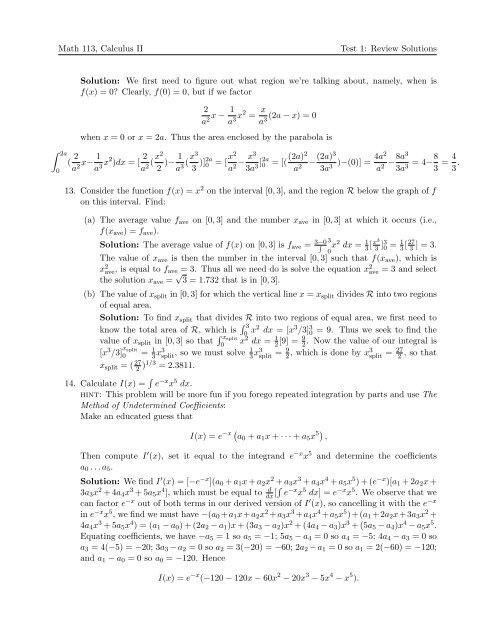Solutions to Practice Problems
Solutions to Practice Problems
Solutions to Practice Problems
You also want an ePaper? Increase the reach of your titles
YUMPU automatically turns print PDFs into web optimized ePapers that Google loves.
Math 113, Calculus II<br />
Test 1: Review <strong>Solutions</strong><br />
∫ 2a<br />
0<br />
Solution: We first need <strong>to</strong> figure out what region we’re talking about, namely, when is<br />
f(x) = 0? Clearly, f(0) = 0, but if we fac<strong>to</strong>r<br />
2<br />
a 2 x − 1 a 3 x2 = x (2a − x) = 0<br />
a3 when x = 0 or x = 2a. Thus the area enclosed by the parabola is<br />
( 2 a 2 x− 1 a 3 x2 )dx = [ 2 a 2 (x2 2 )− 1 a 3 (x3 3 )]2a 0 = [ x2<br />
a 2 − x3<br />
3a 3 ]2a<br />
0 = [( (2a)2<br />
a 2<br />
− (2a)3 4a2<br />
)−(0)] =<br />
3a3 a 2 −8a3 3a 3 = 4−8 3 = 4 3 .<br />
13. Consider the function f(x) = x 2 on the interval [0, 3], and the region R below the graph of f<br />
on this interval. Find:<br />
(a) The average value f ave on [0, 3] and the number x ave in [0, 3] at which it occurs (i.e.,<br />
f(x ave ) = f ave ).<br />
Solution: The average value of f(x) on [0, 3] is f ave = 3−0 ∫<br />
3 0 x2 dx = 1 3 [ x3<br />
3 ]3 0 = 1 3 [ 27 3 ] = 3.<br />
The value of x ave is then the number in the interval [0, 3] such that f(x ave ), which is<br />
x 2 ave, is equal <strong>to</strong> f ave = 3. Thus all we need do is solve the equation x 2 ave = 3 and select<br />
the solution x ave = √ 3 = 1.732 that is in [0, 3].<br />
(b) The value of x split in [0, 3] for which the vertical line x = x split divides R in<strong>to</strong> two regions<br />
of equal area.<br />
Solution: To find x split that divides R in<strong>to</strong> two regions of equal area, we first need <strong>to</strong><br />
know the <strong>to</strong>tal area of R, which is ∫ 3<br />
0 x2 dx = [x 3 /3] 3 0 = 9. Thus we seek <strong>to</strong> find the<br />
value of x split in [0, 3] so that ∫ x split<br />
0<br />
x 2 dx = 1 2 [9] = 9 2<br />
. Now the value of our integral is<br />
[x 3 /3] x split<br />
0 = 1 3 x3 split , so we must solve 1 3 x3 split = 9 2 , which is done by x3 split = 27 2<br />
, so that<br />
x split = ( 27 2 )1/3 = 2.3811.<br />
14. Calculate I(x) = ∫ e −x x 5 dx.<br />
hint: This problem will be more fun if you forego repeated integration by parts and use The<br />
Method of Undetermined Coefficients:<br />
Make an educated guess that<br />
I(x) = e −x ( a 0 + a 1 x + · · · + a 5 x 5) ,<br />
Then compute I ′ (x), set it equal <strong>to</strong> the integrand e −x x 5 and determine the coefficients<br />
a 0 . . . a 5 .<br />
Solution: We find I ′ (x) = [−e −x ](a 0 + a 1 x + a 2 x 2 + a 3 x 3 + a 4 x 4 + a 5 x 5 ) + (e −x )[a 1 + 2a 2 x +<br />
3a 3 x 2 + 4a 4 x 3 + 5a 5 x 4 ], which must be equal <strong>to</strong> d<br />
dx [∫ e −x x 5 dx] = e −x x 5 . We observe that we<br />
can fac<strong>to</strong>r e −x out of both terms in our derived version of I ′ (x), so cancelling it with the e −x<br />
in e −x x 5 , we find we must have −(a 0 +a 1 x+a 2 x 2 +a 3 x 3 +a 4 x 4 +a 5 x 5 )+(a 1 +2a 2 x+3a 3 x 2 +<br />
4a 4 x 3 + 5a 5 x 4 ) = (a 1 − a 0 ) + (2a 2 − a 1 )x + (3a 3 − a 2 )x 2 + (4a 4 − a 3 )x 3 + (5a 5 − a 4 )x 4 − a 5 x 5 .<br />
Equating coefficients, we have −a 5 = 1 so a 5 = −1; 5a 5 − a 4 = 0 so a 4 = −5; 4a 4 − a 3 = 0 so<br />
a 3 = 4(−5) = −20; 3a 3 − a 2 = 0 so a 2 = 3(−20) = −60; 2a 2 − a 1 = 0 so a 1 = 2(−60) = −120;<br />
and a 1 − a 0 = 0 so a 0 = −120. Hence<br />
I(x) = e −x (−120 − 120x − 60x 2 − 20x 3 − 5x 4 − x 5 ).
















